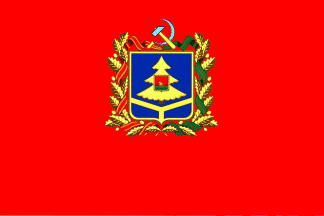
Last modified: 2007-04-14 by antónio martins
Keywords: bryansk | hammer and sickle (proper) | cannon | cannon ball | coat of arms (tree: yellow) | law | novozybkovo | hemp | dunaev (oleg) |
Links: FOTW homepage |
search |
disclaimer and copyright |
write us |
mirrors

(Note: You need an Unicode-aware software and font to correctely view the cyrillic text on this page. See here transliteration details).
The flag of Briansk Region is red with coat of arms.
Jaume Ollé, 20 Feb 1999
Summary of LAW on SIMBOLS of BRYANSK REGION, adopted by the Duma (regional parliament)on November 05, 1998:
Flag is deep red [russian bordoviy] (1:1,5) with the coat of arms in the centre.CHAPTER II
The coat of arms of Bryansk Region established this Law is symbolize an historical traditions of Bryansk Region. The blazon of coat of arms is in the attachment 1 for this Law.CHAPTER III
The flag of Bryansk Region is a rectangular one with dimensions 1:1,5. The description is in attachment 2 for this Law
bry.gif)
The Coat of Arms of the Bryansk Region symbolized the
unity of the three great Slavonic Nations. It reflects a
couple of conceptions, historically traditional for Bryansk
Land, in particular, such conceptions, as the Battle Glory,
the Workmanshift, the Tillage. The historical
Coat of Arms of the Bryansk city
placed in a center of the Coat of Arms
of the Bryansk Region, it reflects the historical succession.
Pascal Gross, 20 Feb 1999
The coat of arms of Bryansk Region:
Gules (the symbol of Pan-Slavonic unity); three Gold rays diverge from
one point in the low part of shield and divide it on three parts in its
base (Russia,
Belorus’ and
Ukraina). The Gold fir-tree with three-tier
crone is on the upper (and the biggest) field (the symbol of greatest
Bryansk’s thickets). Above all is the
coat of arms of Bryansk city
— the capital of Region.
The shield is surrounded with the oak-wreath Proper (as symbol of
federal status) tied with a Orders Ribbons: On dexter —
Lenin’s Order (Region was awarded in 1967), on sinister — Medal
of Guerilla warfare and surmounted with a Hammer and Sickle which
symbolizing the unity of workers and peasants and that the Region
has been created under Soviet power.
Michael Simakov, 25 Jan 2000
bryan.gif)
Some 250 kilometers southwest of Moscow in the Bryansk region,
a yellow, green and white flag now flies above the town hall.
In the top left-hand corner cannabis is depicted, a plant
more widely known for its allucinogenic qualities.
For Novozybkovo, a quiet provincial town of 43 000 that
suffered greatly from the nuclear disaster at Chernobyl, the plant
is a symbol of a long-gone glorious age when the town was a vital
cog in the country’s navy.
In the 18th and 19th century, Novozybkovo was a major supplier of
hemp, the tough coarse fiber of the cannabis plant. A factory in
the town supplied the Russian Navy with the hemp used for ropes,
and the plant was honored when it was placed on the town’s coat of
arms in the first quarter of the 19th century. Russia’s defeat in
the Crimean War in 1856 had a crippling effect on the industry,
and the decimated Russian Navy’s need for hemp died out, said Oleg
Dunayev, who works at a local museum and helped the town pick the
flag’s design.
Hemp was cultivated until the start of the 20th century but died
out completely with Stalin’s campaign to set up collective farms.
The only protests in Novozybkovo, city officials said,
have been from local Communists. They didn’t like the color of the
flag and wanted it to be red.
Phil Nelson, 05 Apr 2003,
quoting and resuming from
Kevin O’Flynn / Moscow Times
Anything below this line was not added by the editor of this page.